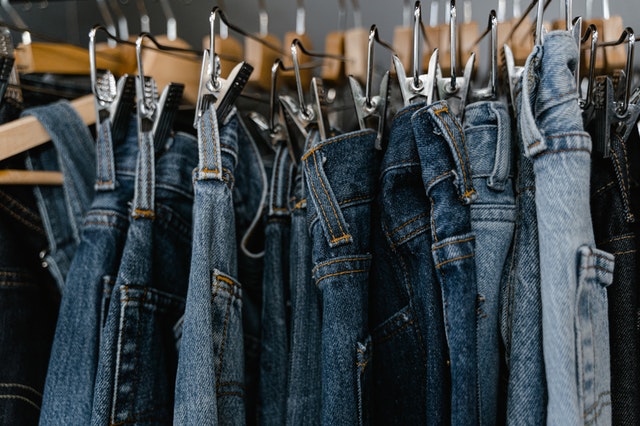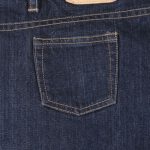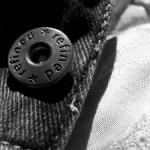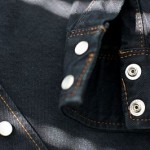Jeans aren’t made entirely of denim. While you can find them in different cuts, colors and even types of denim, they all feature fasteners. Buttons and rivets, for instance, are used to make jeans. From straight-leg and wide-leg to cropped and high-rise, all jeans have buttons and rivets. As fasteners, they are used to secure the denim fabric in place. For a better understanding of buttons and rivets, including how they differ, keep reading.
What Are Buttons?
Buttons are fasteners consisting of a circular piece of solid material. They are used in conjunction with a loop on an adjacent piece of fabric. Also known as a buttonhole, the loop is designed to secure the button. You can unfasten buttons by pulling them out of the buttonholes. You can fasten buttons, on the other hand, by sliding them through the buttonholes. Buttons are simply circular, disc-shaped fasteners that are designed for use with buttonholes.
There are snaps as well. Snaps look like buttons, but they live up to their namesake by snapping into place. You can push snaps into a corresponding backing. Assuming you use enough force, it will pop into the backing. To unfasten a snap, you can pull it out of the backing. Buttons are always used in conjunction with a buttonhole, whereas snaps are not. Snaps are button-like fasteners that snap into and out of a backing.
What Are Rivets?
Rivets are permanent fasteners that are used to reinforce areas of a garment. They are commonly found on jeans. Most jeans have over a half-dozen rivets, and some of them have even more rivets. Regardless, rivets have become synonymous with jeans. Nearly all jeans are designed with buttons and rivets.
Rivets are circular, disc-shaped fasteners — just like buttons. But rivets are permanent fasteners, meaning you can’t fasten or unfasten them. Manufacturers add rivets during the construction of new jeans, at which point they become permanent.
You can see examples of rivets in the photo below. The brass-colored fasteners on the corners of the pockets are rivets. While placements vary, rivets are typically found around the pockets and other seams.

Differences Between Buttons and Rivets
While they are both found on jeans, buttons and rivets aren’t the same. Buttons are temporary fasteners, whereas rivets are permanent fasteners. You can fasten and unfasten buttons. To fasten a button, you just need to slide it through the corresponding buttonhole. To unfasten a button, you just need to pull it out of the corresponding buttonhole.
There’s no way to fasten or unfasten rivets. As permanent fasteners, rivets aren’t adjustable. You can fasten them, nor can you unfasten them. The opposite is true for buttons. Buttons are temporary fasteners. When putting on a pair of jeans, you may want to unfasten the button or buttons. You can then fasten the button or buttons so that the jeans stay around your waist.
Buttons and rivets are used in different places. Buttons are typically found on the fly. All jeans have a fly, and most of them feature at least one button for the fly. Jeans with a single-button fly typically feature a zipper with one button on the top. Other jeans don’t have a zipper for the fly. Instead, the fly consists of a full column of buttons.
Buttons and rivets are also used for different purposes. Buttons provide a mechanism for securing the fly on jeans. In comparison, rivets are used to reinforce jeans so that they are better protected against damage. Rivets essentially hold the denim fabric in place.
You won’t find rivets on the fly. As previously mentioned, they are used primarily to reinforce jeans. Buttons and rivets are also used for different purposes. Buttons provide a mechanism for securing the fly on jeans. Most jeans only feature buttons on the fly. Whether it’s a single-button or multi-button fly, you won’t find them elsewhere. Rivets, conversely, are found on the corners of pockets and, in some cases, other seams.
Both buttons and rivets have been used to make jeans for over a century. Some of the first jeans to hit the market, in fact, featured buttons and rivets. Since then, little has changed regarding their use. Jeans are still made with buttons and rivets. Button are temporary fasteners found on the fly, whereas rivets are permanent fasteners found on the corners of the pockets and seams.
How to Identify High-Quality Buttons and Rivets
When shopping for jeans, you should pay attention to the buttons and rivets. The quality of these fasteners can vary. Some jeans are designed with high-quality buttons and rivets, whereas others are designed with low-quality buttons and rivets.
Low-quality buttons and rivets are more susceptible to damage. Buttons require manually fastening and unfastening. When made of a cheap material or poor craftsmanship, a button may fall off when you fasten or unfasten it. You can always attempt to reattach buttons using a needle and some thread. A better solution, though, is to choose jeans with high-quality buttons.
Low-quality rivets can prove equally problematic. Rivets provide structural reinforcement. Low-quality rivets, unfortunately, may not stay in place. They may come out of the denim fabric, thus leaving the jeans vulnerable to damage.
You can identify high-quality buttons and rivets by inspecting the material from which they are made. Low-quality buttons and fasteners are typically made of a cheap material, such as plastic or aluminum. High-quality buttons and rivets are made of a premium material like brass or even stainless steel. By choosing jeans with high-quality buttons and rivets, you won’t have to worry about them falling off. They’ll stay in place while offering a higher level of aesthetics in the process.
In Conclusion
Buttons and rivets are fasteners that are commonly found on jeans. Buttons are found on the fly, whereas rivets are found on the corners of the pockets and the seams. Only rivets, however, are permanent fasteners. Buttons are temporary fasteners that you can slide through a buttonhole to secure them in place.











